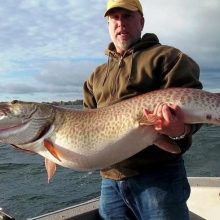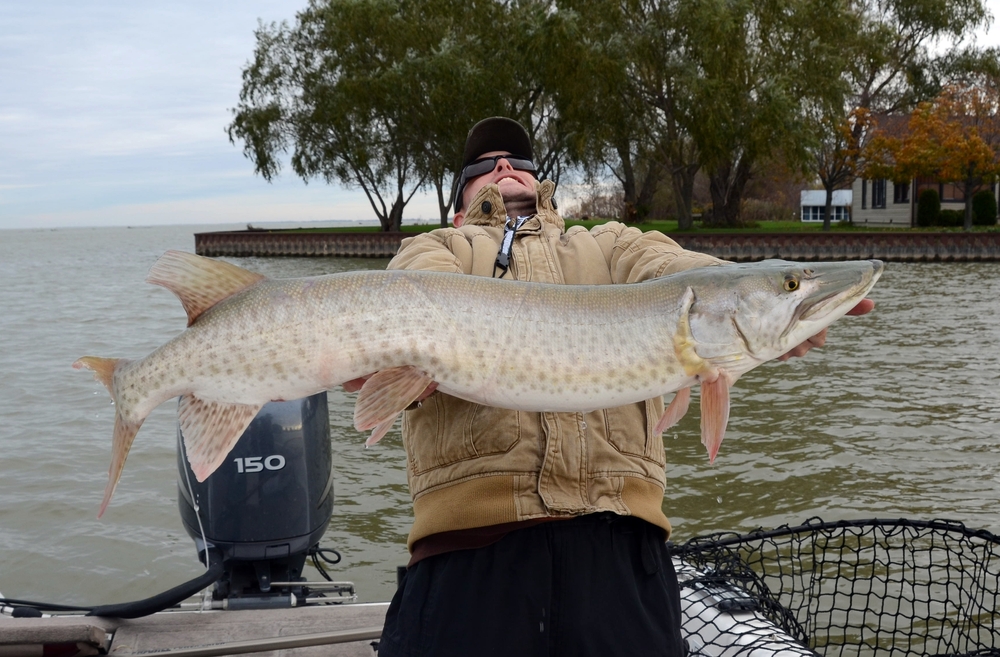This article may contain affiliate links. If you make a purchase after clicking on a link we may earn a small commission at no extra cost to you. As an Amazon Associate, I earn from qualifying purchases.
Trolling for Musky – Tips & Tricks

Without a doubt trolling for musky can be on of the most productive ways to cover a lot of water, especially if you are new to the lake that you are fishing on.
Easily the most popular method to catch large muskie at it’s core it’s pretty simple:
Drag a lure behind your boat at the right speed at the right place and depth
Sounds so simple a child could do it.
However there are a few subtleties that can make all the difference between skunking out and landing the tiger muskie of a lifetime.
Trolling for Musky
Most people who troll for musky will generally do so on the edge of a weed bed in a large lake.
This is by far the most popular way to find them and then present them with a lure.
Lure size, location, time of year, trolling speed and depth are probably the most important variables to get right.

Musky Trolling Tackle
The main tackle is usually a good quality trolling rod for musky, either a conventional or a baitcasting reel and heavy main line such as 80lb paired with a wire leader.
For deeper trolling you may wish to use a downrigger or even lead core line depending on the situation.
Regardless of your setup all musky tackle and gear is much heavier than bass or trout so it’s best to size up your gear to suit them.
Lure Size
Given that they are one of the largest freshwater predators around it is perfectly natural for a beginner to choose as big a lure as possible.
That’s not always the case however and musky have bee known to hit some pretty small crankbaits and swimbaits.
All they need is plenty of shine and a little bit of wobble put in front of them to bring out their inner predator. If a muskie is hungry enough they’ll even hit a plastic worm!
That being said larger lures do tend to attract the larger fish. One nice side affect of using a large lure is that smaller fish are less likely to hit your lure.
Musky Trolling Speed
Although a big lazy muskie will hit a lure that’s just being twitched on the water surface most people do prefer to troll somewhere in the range of about 2-10 miles per hour:
- 2-4 mph – in shallow waters and in cold waters
- 4-6 mph – most popular speed for muskie
- 6-10 mph – usually in warm summer months
Of course the depth and type of lure that you use will have a huge impact on the speed at which you troll.
Location
Muskie are mostly ambush predators and given their markings it’s easy to see why they favor weed beds and other dark structures that can help to camouflage them from their prey.
Given their size they do tend to stay out a little bit deeper than say a pike would but they will still generally both patrol and lie in wait along the deeper edges of larger weed beds.
Also Read: Pike vs Muskie
In summer months they can be found in shallower waters and some will actually spend a few hours motionless quite close to the surface sunbathing during the summer heat.
Time of Year
Mushy tend to stick to two different locations and that is usually dictated to as to the time of year and the temperature.
In spring/summer months they will tend to move towards the shallower waters and the temperature is around 60 degrees.
In the winter months they will move to the deeper waters at about 40 degrees.
Musky Trolling Depth
As mentioned above the time of year has a big impact on the depth that you will find muskie.
Trolling along the edge of a weed bed using a fish finder is by far the most consistent way to troll where the fish are.
However you can also target the bigger fish in much deeper waters. You’ll need some specialist tackle to get your lures down deeper than they are designed to swim such as:
- Downrigger
- Planer boards
- Lead core lines
Everyone has there preference as to which one to use personally I will always favor a downrigger as I believe it gives the best possible control of the depth that your lure is swimming.
